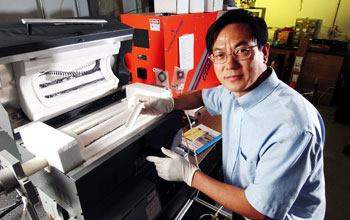Multimedia Gallery
Nanohelix Structure
Nanohelix Structure
Zhong Lin Wang, professor in the Georgia Tech School of Materials Science and Engineering, prepares to load a sample into a furnace used to create the new zinc oxide nanohelix structures.
This new, previously-unknown zinc oxide nanostructure, that resembles the helical configuration of DNA, could provide engineers with a new building block for creating nanometer-scale sensors, transducers, resonators and other devices that rely on electromechanical coupling. The research was sponsored by the National Science Foundation, NASA Vehicle Systems Program, U.S. Department of Defense Research and Engineering (DDR&E), the Defense Advanced Research Projects Agency (DARPA), and the Chinese Academy of Sciences.
To learn more, see the Sept. 8, 2005, Georgia Tech Research News, "Superlattice Nanobelts: Nanohelix Structure Provides New Building Block for Nanoscale Piezoelectric Devices." (Date of Image: Sept. 2005)
Credit: Photo by Gary Meek; courtesy Georgia Tech
Images and other media in the National Science Foundation Multimedia Gallery are available for use in print and electronic material by NSF employees, members of the media, university staff, teachers and the general public. All media in the gallery are intended for personal, educational and nonprofit/non-commercial use only.
Images credited to the National Science Foundation, a federal agency, are in the public domain. The images were created by employees of the United States Government as part of their official duties or prepared by contractors as "works for hire" for NSF. You may freely use NSF-credited images and, at your discretion, credit NSF with a "Courtesy: National Science Foundation" notation.
Additional information about general usage can be found in Conditions.
Also Available:
Download the high-resolution JPG version of the image. (3.9 MB)
Use your mouse to right-click (Mac users may need to Ctrl-click) the link above and choose the option that will save the file or target to your computer.

